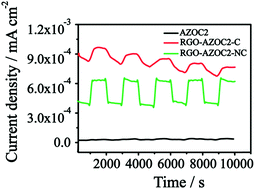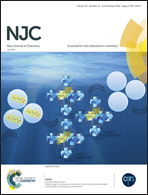Photoresponse modulation of reduced graphene oxide by surface modification with cardanol derived azobenzene†
Abstract
The process of utilizing organic molecules for tuning carbon nanomaterials has paved the way to a tremendous revolution in organic electronics, especially in developing field effect transistors, memory devices etc. Here we report the influence of insulating photochromic molecules on the conductance behaviour of carbon nanomaterials. Azobenzene derived from cardanol was functionalized with reduced graphene oxide and this combination showed a phototunable conductance behaviour with the light induced trans–cis isomerisation of an azo moiety. The difference in the mode of interaction between the two moieties, i.e. covalent and non-covalent functionalization, influences the photoconductance behaviour of reduced graphene oxide. The rate constant of photoisomerisation for the covalent hybrid is 0.04259 and for the non-covalent hybrid is 0.04687. Similarly, the photoresponse ratio calculated for the covalent hybrid system is 0.178 and the same for the non-covalent hybrid is 0.571. This clearly implies that the non-covalent mode offers better tuning of photoconductance than the covalent mode as the latter can cause a larger restriction in the photo-isomerisation activity of the azosystem. This finding will lead to more development in the area of sustainable molecular electronics.



 Please wait while we load your content...
Please wait while we load your content...